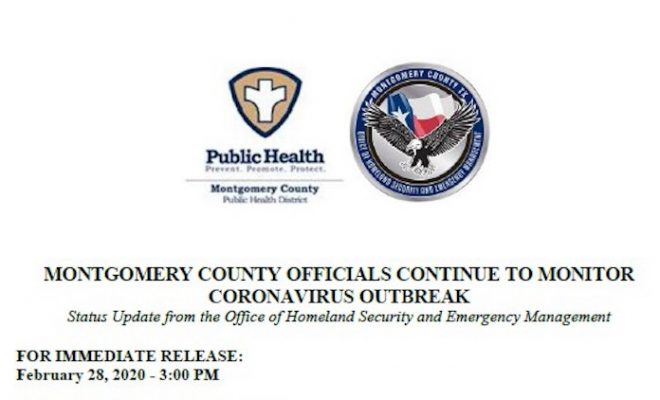
Health
Montgomery County Officials continue to monitor Coronavirus Outbreak
The following is a status update provided by the Montgomery County Office of Homeland Security and Emergency Management released on February 28, 2020 at 3 p.m.
Montgomery County Public Health District, in conjunction with the Montgomery County Office of Emergency Management and Homeland Security, continue to monitor the coronavirus outbreak that began in Wuhan, China in December 2019. There still have been no suspected cases in our county, but we are diligently working with our partners at the Texas Department of Health and Human Services (DSHS) and the Centers for Disease Control (CDC) to keep our healthcare providers in the county and the public informed.
For the general American public, who are unlikely to be exposed to this virus, the immediate health risk from COVID-19 is considered low. At this time, there is no vaccine to protect against COVID-19, and no medications approved to treat it. Non-pharmaceutical interventions like hand-washing, disinfecting surfaces around your home, and staying home when you are sick are the most important response strategies.
Imported cases of COVID-19 in travelers have been detected in the U.S. Person-to-person spread of COVID-19 also has been reported among close contacts of returned travelers from Wuhan. On February 25, the CDC confirmed COVID-19 in a person in California who reportedly did not have relevant travel history or exposure to another known patient with COVID-19 (unknown exposure). But, to be clear, the virus is NOT currently spreading in the community in the United States.
The CDC has confirmed multiple cases of novel coronavirus 2019 in people under federal quarantine at JBSA-Lackland in San Antonio. The first was a traveler who returned on a U.S. State Department-chartered flight from Wuhan City, China. The others returned on a State Department flight for passengers from the Diamond Princess cruise ship quarantined in Yokohama, Japan. The individuals will remain isolated at medical facilities until they test negative for the virus and are no longer at risk of spreading it.
There are no other cases in Texas, and these cases do not change the risk of infection for Texans because the patients have been under federal quarantine since their return and have not interacted with the public. Although the risk for the general public in Texas remains low, the Texas Department of State Health Services is urging health care professionals to ask patients with respiratory symptoms about their travel history and contact their local or regional health department if they think a patient may have COVID-19. DSHS is working with local health departments to monitor and assess people with recent travel to China for possible COVID-19 testing.
All travelers who have returned from China should stay home and monitor themselves for symptoms for 14 days after they were last in China. They should consult with a health care provider if they develop fever, cough or shortness of breath within that period. Local health departments across the state are in contact daily with returned travelers to verify that they remain symptom-free.
Human coronaviruses most commonly spread from an infected person to others within about six feet through respiratory droplets released into the air by coughing and sneezing, close personal contact, such as touching or shaking hands; touching an object or surface with the virus on it, then touching your mouth, nose, or eyes before washing your hands; and rarely, fecal contamination.
Patients with confirmed 2019-nCoV infection have reportedly had mild to severe respiratory illness with symptoms of fever, cough, and/or shortness of breath. The CDC believes that symptoms of 2019-nCoV may appear in as few as 2 days or as long as 14 days after exposure.
If you are a healthcare provider, be on the look-out for people who recently traveled from China and have fever and respiratory symptoms. If you are a healthcare provider caring for a COVID-19 patient or a public health responder, please take care of yourself and follow recommended infection control procedures. If you have been in China or have been exposed to someone sick with COVID-19 in the last 14 days, you will face some limitations on your movement and activity. Cooperation is integral to the ongoing public health response to try to slow spread of this virus. If you develop COVID-19 symptoms, contact your healthcare provider, and tell them about your symptoms and your travel or exposure to a COVID-19 patient before arriving to seek medical care.
The best way to prevent infection is to take precautions to avoid exposure to this virus, which are similar to the precautions you take to avoid the flu.
- Wash your hands often with soap and water for at least 20 seconds. If soap and water are not available, use an alcohol-based hand sanitizer.
- Avoid touching your eyes, nose, and mouth with unwashed hands.
- Avoid close contact with people who are sick.
- Stay home when you are sick.
- Cover your cough or sneeze with a tissue, then throw the tissue in the trash.
- Clean and disinfect frequently touched objects and surfaces.
For more information, please see https://www.dshs.texas.gov/coronavirus/.
Montgomery County Public Health District’s mission is promoting a healthy, resilient community through health education, disease prevention, clinical services, and emergency preparedness. For more information about the Montgomery County Public Health District please go to www.mcphd-tx.org.
Source: Montgomery County Office of Homeland Security and Emergency Management



























